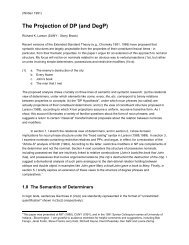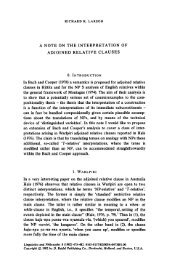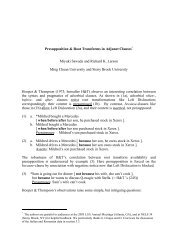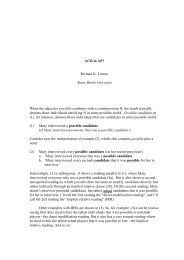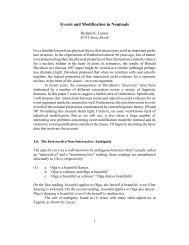Intensional Transitive Verbs and Abstract Clausal Complementation
Intensional Transitive Verbs and Abstract Clausal Complementation
Intensional Transitive Verbs and Abstract Clausal Complementation
Create successful ePaper yourself
Turn your PDF publications into a flip-book with our unique Google optimized e-Paper software.
<strong>Intensional</strong> <strong>Transitive</strong> <strong>Verbs</strong> <strong>and</strong> <strong>Abstract</strong> <strong>Clausal</strong> <strong>Complementation</strong><br />
b.<br />
DP<br />
Polly<br />
VP<br />
V<br />
hopes<br />
V’<br />
XP<br />
e<br />
CP<br />
C<br />
for<br />
C’<br />
DP<br />
PRO<br />
AgrsP<br />
Agrs’<br />
Agrs TP<br />
T<br />
TO<br />
DP<br />
t<br />
VP<br />
V<br />
HAVE<br />
V’<br />
D<br />
a<br />
DP<br />
NP<br />
cracker<br />
As discussed above, PRO in this structure is assumed to be licensed by a light NOM. Assume further<br />
that the silent verb HAVE is a purely semantic element in the sense of bearing only interpretable<br />
features 24 - in particular, assume that HAVE bears no Case feature. This entails that there is no Agr o P<br />
present in the embedded infinitival clause. The structure, as it st<strong>and</strong>s, thus presents a dual case problem:<br />
on the one h<strong>and</strong>, the for complementizer has no obvious way of checking its Case feature; on the other<br />
h<strong>and</strong>, the chain headed by a cracker has no clear way of receiving Case. PRO is unavailable for the<br />
former, <strong>and</strong> HAVE is unavailable for the latter.<br />
Suppose now that this structure is subject to restructuring along the lines of Baker’s analysis of the<br />
Italian cases. First VP raises to CP Spec position. From this position the inaudible verb HAVE<br />
incorporates into the matrix V forming the complex predicate hopes-HAVE. Furthermore, the<br />
complementizer for incorporates into the matrix V, as it always does in infinitival complement structures of<br />
this kind (43): 25<br />
24 See also Parsons (1997) for a recent defense of the proposal that intensional transitives of the want-class embed<br />
an implicit HAVE. See Forbes (1997b) for an interesting alternative approach to the whole issue of intensional<br />
transitivity, extending the so-called "hidden indexical" theory. We should note that although we treat HAVE in these<br />
trees as a primitive element, our analysis not committed to this point. Indeed, we indicated in fn.5 (see discussion of<br />
(iv)) good reasons to think that have is composed of be + a dative element; it appears plausible to extend the same<br />
analysis to HAVE.<br />
25 We will take no st<strong>and</strong> on the order in which the two incorporations take place, <strong>and</strong> the exact form of the resulting<br />
head-adjunction structure. Accordingly, we represent the derived V-complex by means of a triangle.<br />
17



